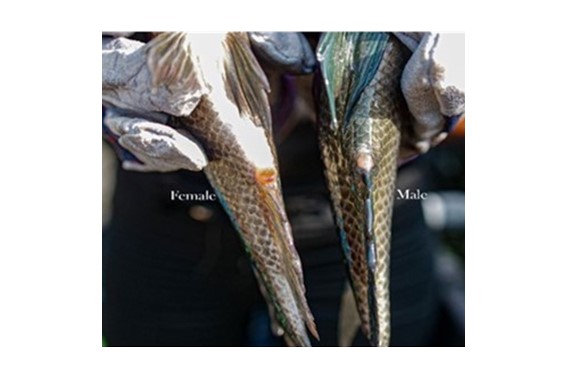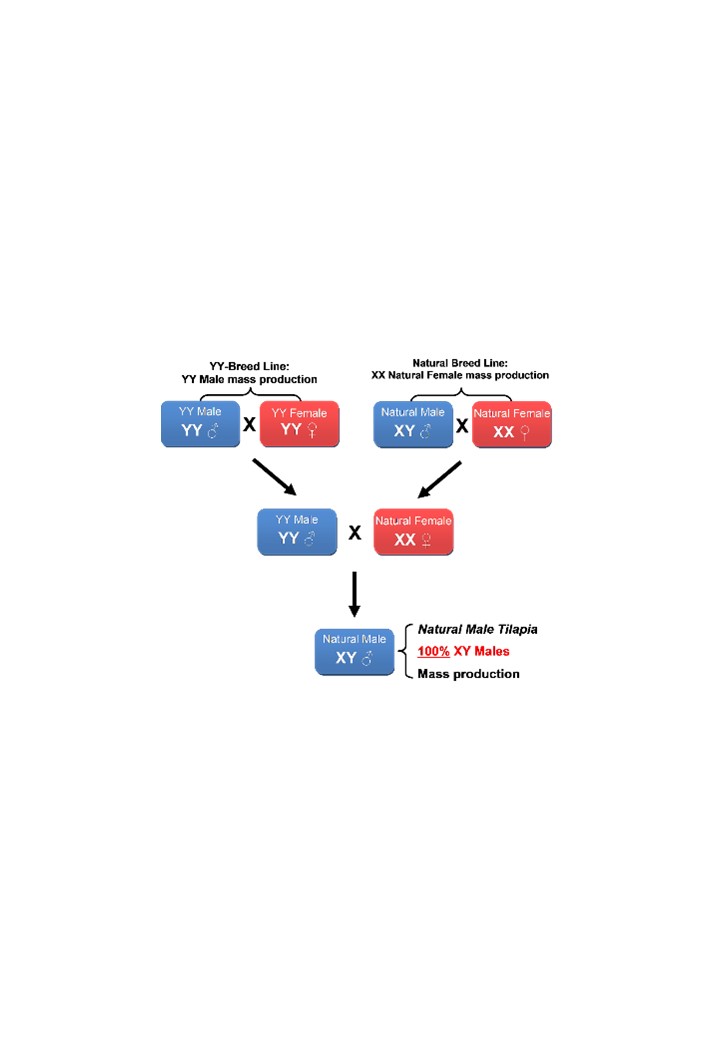All Male Tilapia Fingerlings with Greater Yield and Uniformity
Summary
Tilapia is one of the most important farmed fish and is historically among the first breeds cultivated by humans. The group belongs to the Cichlid species that originated in Africa. Tilapia is easy to farm in different systems ranging from low-tech earthen ponds to intensive high-tech tanks and cages. Some of the limitations in producing tilapia are its small size, slow growth rate and frequent reproduction in captivity. This is because large amounts of metabolic energy go toward reproduction in gestating female tilapia, their growth rate is slowed down and the conversion of feed to flesh is reduced. Male tilapias are bigger and more attractive for production because more of their metabolic energy is channeled toward weight gain, which increases their growth rate and conversion of feed to flesh. Males grow faster and larger, they are therefore more profitable for producers and more acceptable to consumers. The mono-sex male technology was introduced by WorldFish and has rapidly gained popularity with small-scale producers in Africa. The GIFT technology is based on selective breeding processes where brood parents are carefully monitored to obtain improved performance for certain traits that are important for production.
About the Solution
Mixed sex tilapia culturing is technically easy but is associated with lower yields and smaller and non-uniform harvests. Mono-sex culture is more complex, but it is possible to produce all male tilapia fingerlings — as high as 98%. A mono sex, all male tilapia stock is obtained through manual sex selection, hormonal alteration or YY natural male technology (NMT). Genetically improved farmed tilapia (GIFT) transferred from selective breeding programs is ideal for commercial production. In the manual selection, female and male fingerlings are visually separated at the start of the production cycle but this is time-consuming, and nearly half of the stock will be discarded. Alternatively, for commercial production, hormonal alteration of fry is performed by application of the masculine hormone α-Methyltestosterone to the fry feed converting the sex of most fish (98%) from female to male. Another approach to sex management relies upon temperature change up to 36°C shortly after hatching, converting the sex of most fish (86%) from female to male, although many of the fry may perish in the process. The end-product of NMT is a complete natural male stock with XY-chromosome, whereas for hormone sex-reversed 50% of the phenotypically males are genetically female.
Culturing mono-sex tilapia is of great importance to aquaculture practice in all African countries because temperatures are highly suitable for fast growth. It offers substantial benefit in terms of its growth and yield per unit area with uniform sizes at harvest. Improved mono-sex tilapia is more resistant to disease, tolerant to adverse weather, and can tolerate broader temperature (12-40°C) and salinity levels (12-15 ppt). Farming of mono-sex tilapia is especially attractive in countries with a strong demand for tilapia such as DR Congo, Ghana, Malawi, Nigeria, Uganda, and Zambia. The process of monosex production using MT hormone is not prohibited, as the European Union and United States markets allow tilapia to be imported from countries producing monosex tilapia. The ministerial decree organizing this issue states that mixing hormone with feed should be done with caution in feed mills.
A large range of tilapia breeds can be used for manual selection, hormonal treatment, YY male technology and GIFT but improved lines are most favorable as they possess traits that further benefit growth rate, feed conversion, size, and hardiness. Crossbreeding of male Blue tilapia (Oreochromis aureus) or Wami tilapia (O. urolepis) and Greenhead tilapia (O. macrochir) with female Nile tilapia (O. nilotica) results in 100% male offspring. Male Blue and Zanzibar tilapia (O. hornorum) that brood with Mozambique tilapia (O. mossambicus) also have exclusively male offspring. Nile tilapia is highly popular due to its faster growth and ability to grow to larger size over a wide range of environmental conditions. Its disease resistance and ability to efficiently utilize very diverse food sources also make it an ideal candidate for culture. A range of sterile transgenic breeds has been developed that can achieve a harvest weight up to 2 kg. Successful farming of mono-sex tilapia requires hatcheries to select and manage brood stock for high quality and quantity of fish seeds. Younger brooders of 1 to 1.5 year old weighing at least 300 g and free of wounds and parasites are needed.
Normally, brooders are stocked into the spawning units (tanks or hapas) about 15 days before the spawning season. Keep males and females in separate tanks or hapas for feeding before spawning. Feeding starts as on the day following stocking. The water temperature should be raised gradually up to 26°C. After confirming that females are ready to ovulate, both sexes are stocked into the spawning units at a rate of 2 females to 1 male. The average weight of broodstock in each spawning unit must be kept almost equal. Female brood stock must be regularly checked for eggs. If they carry eggs in their mouths, collect the eggs and transfer into the hatching jars, where the incubation period is completed until hatching occurs. After 10-12 days (according to temperature) have elapsed, the newly hatched fish, also called “fry”, can be moved from brooder basins to rearing units. The hormonal mono-sex technology uses a rate of 60 mg artificial testosterone per kilogram of feed. Fry have to be continuously fed with the hormonal agent for 21 days to ensure sexual inversion to a male rate of 98%. After treatment, there should be a few fry under 14 mm in size. In the GIFT method, full-sibling families of fish are reared in small, separate enclosures.
Commercialization
Commercially available
Solution Images
Institutions




